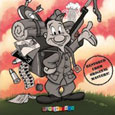Pat Sullivan Productions (1919-1924), Bosko Video/Image Entertainment (April 20, 1999), single disc, 119 mins plus supplements, 1.33:1 original full frame ratio, Dolby Digital 2.0 Stereo, Not Rated, Retail: $9.99
Storyboard:
History’s first cartoon star embarks on numerous magical adventures.
The Sweatbox Review:
(For more history on these cartoons, please see our feature Otto Messmer And Felix The Cat.)
When it comes to Felix the Cat, DVD buyers have a few choices on the market that they can pick from in order to sample what the old cartoons were like. The subject of this review is perhaps the most comprehensive offering to date, although it was an early DVD and is lacking in many ways. Nevertheless, there is some good stuff on the disc, and it may be the best we will see for a while.
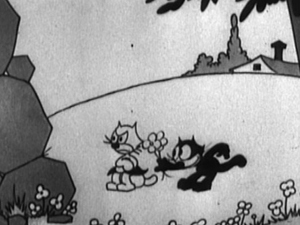
Felix’s success in the early part of the twentieth century was largely based on the artistry of Otto Messmer, and the entrepreneurial skills of Pat Sullivan. Felix was to the 1920s what Mickey Mouse was to the 1930s, a fresh cartoon character that opened up new possibilities in the art of animation and became the subject of a huge merchandising blitz. Felix was pushed to the sidelines by the advent of sound cartoons, but would stay in the public eye via his newspaper strip, comic books, and ongoing merchandising. He would then rebound in later years with a popular television cartoon show, and remains a viable and marketable character to this day.
But it all started back in 1919, just as this DVD does. The disc contains 16 cartoons from 1919 to 1924, showcasing the earlier, pre-cuddly Felix in their proper speed. Those looking for the rounder Felix may be a bit disappointed, but hopefully the appeal of these cartoons will still be apparent to viewers interested in animation history.
The disc plays its program automatically, but a menu option may be selected from the remote control. First to appear is the Bosko Video logo, followed by an introduction to “Volume 1”, with historical information. This DVD is really an exact duplication of two 1993 VHS tapes, and it plays just like it— similar to Bosko Video and Image’s Complete Uncensored Private Snafu DVD.
Paramount Magazine (1919) – This newsreel segment featured three short cartoons, including the first Felix, more or less. All three of the cartoons are presented on this disc. First up is a Bobby Bumps cartoon by Earl Hurd, Their Master’s Voice. In this cartoon, Bobby and his puppy climb out of a photographed ink bottle, and they call their boss on the phone. The boss calls them over to work at his house, the dog swats a fly with a pencil but hits Bobby… and that’s it. The short has limited action, little humor, and zero charisma. No wonder Felix was such a sensation in this era!! (Note that Bobby is under the same chapter as the logos and intro, so skipping past them brings you past Bobby and onto Feline Follies.)
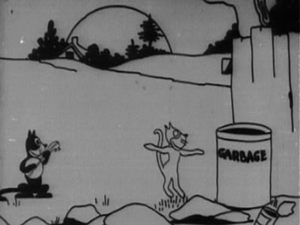
Feline Follies, by comparison, is a masterpiece. (I said, “by comparison”, so don’t set your expectations too high.) Pat Sullivan, as would be the case for the next decade or so, gets credit on the title card for the cartoon, even though we all know by now that Messmer did the story and animation all by himself. Feline Follies actually had as its star a cat named Master Tom, but he was to be renamed Felix two cartoons later. Some of Felix’s trademark gimmicks are already seen here, such as his tail turning into a question mark, or plucking musical notes out of the air in order to use them as a mode of transport. Tom meets and woos a young feline, and they speak to one another in rectangular word balloons, as was customary in early silent cartoons. While he is away, mice trash his home, and he is kicked out. He decides to end it all at the gasworks, showing just how much of a one-shot idea this cartoon originally was.
The backgrounds in this short and the ones to follow are generally rather plain, consisting of simple line drawings; this makes sense once you know that the backgrounds were usually put on cels for the Felix cartoons, to be laid over the characters who were drawn and filmed on paper.
The last cartoon in the Magazine features Bud and Susie in Down The Mississippi, by Frank Moser. Two kids frolic outside the house. They call a cat over and send it inside, where a Negro woman (to use the terminology of the day, in order to emphasize that this is a racial caricature) gives the cat a copy of Huckleberry Finn. The Sandman puts the kids to sleep, and they dream they are fishing and camping on the Mississippi. Ho-hum.
Felix Saves The Day (1922) – This cartoon was done as a pilot while Sullivan was looking to sign with a new distributor, and it ended up being the first cartoon in the Winkler package. Felix is seen to crawl out of a pen as part of the titles, and then is observed to be playing ball with some neighborhood kids. They get into trouble with a police officer, and one of the kids is thrown into jail after being chased by a flying policeman. The other kids soon are playing in a big game at the stadium, and Felix climbs question marks to visit the prisoner in jail. Felix then goes to the ballpark and… well, you’ve seen the title already. Suffice it to say that the ending is even more whimsical than the rest of the cartoon.
The backgrounds utilize some wash effects to give a greater variety of tones, and some live action photographic plates of buildings and a ballpark are also used, making this cartoon rather unique among the Felixes. Like other cartoons of this age, some racial caricatures are evident, the case here being with the opposing ball players being a “Negro” team. At least those kids were allowed to play against the white boys, I guess, but still the notion of segregation is distasteful today, to say the least.
Felix In The Swim (1922) – Felix rescues a mouse from doom, and the two of them rescue a boy from piano lessons, so that the boy and Felix can go swimming. Observation: It’s funny when the word balloons have spelling errors.

Felix Turns The Tide (1922) – This darker-toned cartoon has Felix leaving his job at the butcher to lead the Cat Army against the Rat Army. Felix hopes to return a hero and then marry his sweetheart, but the realities of war catch up with him as the fighting escalates and the body count rises. This surprisingly sober cartoon no doubt came out of Messmer’s own wartime experiences. It does end on a light note, however, as Felix finds out what his fiancé’s been up to in his absence.
Felix Lends A Hand (1922) – Felix is suffering from a cold winter, and gets his chance to go to Egypt in order to help an Arabic man at a nearby shop. The cat uses a magic carpet to travel to Egypt in order to rescue the man’s girlfriend. In a typically neat trick, Felix and a mouse shoot daggers at each other from their eyes, then use the daggers as swords for a fight. Once again, the story ends in an unexpected fashion, and Felix has to concede failure in his mission.
Felix Minds The Kid (1922) – A hungry Felix gets a babysitting job, only to lose the baby when it sails away with a balloon.
Felix In the Bone Age (1922) – Felix is hunted by a caveman who wants his pelt in order to make a coat for his wife. Felix uses a whole mess of detached tails to rescue himself this time, loaned by a group of monkeys, only to be chased by a gorilla. This entry is less than three minutes long. The rest of the chapter on this disc is the credits for “Volume 1”.
The Volume 2 credits (reflecting the videotape breakup of these cartoons) follow, along with the same scrolling historical text seen earlier.
Felix The Ghost Breaker (1923) – Felix sleeps in a cemetery, when a ghost comes out. Felix follows the ghost to a farm, and offers to help the poor farmer being haunted by the ghost.
Felix Wins Out (1923) – Actually, the title card says “Win’s”, but whose keeping track of typos? The fun plot of this one involves Felix joining the circus and witnessing the breakup of the Fat Lady and the Human Skeleton. If it sounds un-PC already, wait ‘til the rest of it! Felix gets them back together in typically clever fashion, but ruins the Freak Show in doing so.
Felix Revolts (1923) – This politically-charged thriller (okay, maybe there’s some hyperbole there) sees Felix start a cat revolt against City Hall, which treats cats as second-class citizens. The cats wail all night, and refuse to catch rats. Guess which side wins?
Felix Gets Broadcasted (1923) – A misadventure with some power lines blasts Felix to Egypt again in this green-tinted effort.

Felix In Hollywood (1923) – A serious actor laments that he must go into motion pictures in order to make a living. In order to help his master earn money for the trip, Felix rescues a failing shoe business. Once in Hollywood, Felix meets numerous celebrities like Charlie Chaplin, adding to the fun of this picture.
Felix In Fairyland (1923) – After saving a fly that turns out to be a fairy, Felix gets his wish to go to Fairyland and meets fairy tale characters.
Felix Out Of Luck (1924) – Felix has trouble securing a meal.
Felix Goes A-Hunting (1923) – A woman badgers a man for a fur coat, and Felix volunteers to help him out. Felix goes off to shoot rabbits, but encounters a bear instead. At one point, Felix eludes the bear by bouncing off the horizon line after a jump from a height in the foreground. The bear follows Felix to the man and woman’s home… and all ends well. Once again, that Felix earns his reputation for bringing good fortune.
Felix Finds ‘Em Fickle (1924) – Felix fights numerous animals to obtain a flower for his sweetheart from a peak. But was it all worth it?
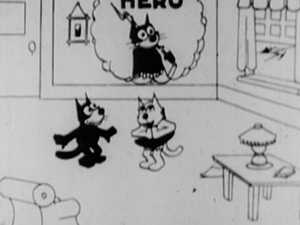
Is This Thing Loaded?
There are no extra features on this disc.
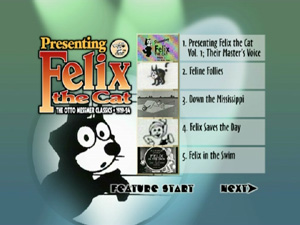
Case Study:
As an early Image offering, this came in a snapper case, but may have later seen an Amaray instead.
Ink And Paint:
Well, one cannot expect too much of films this old, but even given that consideration there is some disappointment to be had. The films are overly windowboxed, likely to hide frayed edges of the transfer source, but it would have been nice to not see so much black on all sides of the screen. One also wonders if the extreme window boxing was really quite as necessary as what appears, as a lot of the picture is obstructed. It is especially noticeable when the side of a word balloon is cut off, cropping off whole or partial words. I cropped the other images for this review, but you can see the full picture here:
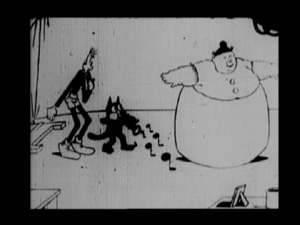
The films additionally sometimes have the problem of slowly bouncing up and down in the frame, which could not have been due to an unsteady camera, since the Sullivan studio used a fixed camera that could not be moved even when it would have made things easier. Some of the video is also out of focus (perhaps a source material issue), with lines fading in and out of sight while others are blobby, most notably in Bone Age (very dark, blurry, and practically unwatchable) and Felix Minds The Kid. There is generally a lot of projector wear noticeable (in the form of copious vertical lines), suggesting these film prints had been viewed many times before they made it to DVD. Naturally, there is also plenty of dust and grain to be had. Video quality for the shorts varies from poor to passable. The print for Felix Gets Broadcasted (the green one) is certainly cleaner than most, though.
Viewers of previous Bosko compilations will be happy to know that there is NO Bosko Video “bug” in the corner of the screen, but a copyright notice for Bosko Video does appear on all the title cards (copyrighting the restoration and score, not the original cartoons of course).
Scratch Tracks:
Naturally, these are silent cartoons, so there are no original audio tracks to consider. An organ score has been added, playing as one piece of music over each of the one-hour “volumes” of material on the disc. The original scoring and arrangements were written and performed by David Wickerham on a Wurlitzer. If you like organ music, the stereo audio should please you.

Final Cut:
There is no doubting the historical significance of these cartoons, but in all honestly this collection will not appeal to everyone. The cartoons are whimsical and fun, but are technically unsophisticated and certainly dated. The transfers are far from wonderful, and the lack of supplemental material is a disappointment. Silent cartoon buffs will still find much to marvel at, though, if they compare Messmer’s work in these cartoons with that of his contemporaries. Messmer brought wit and imagination to these films, and they rightfully brought Felix to fame and fortune (even though Messmer himself did not benefit as much as he should have). This is the most complete DVD on the market, although we see little of the more modern-styled Felix that was established more or less by 1924. It would be wonderful for someone to produce another volume with this title’s number of cartoons, but with some later Felixes. In the meantime, this disc is probably the best bet for those curious to see Felix in his (early) prime. Note that the “Overall” rating for this disc is heavily weighted towards its historical content.
 | ||
 |







